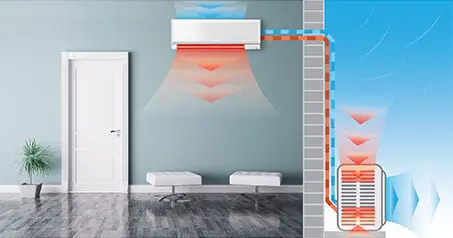20 Years Serving Brisbane to the Sunshine Coast
In need of a Air Conditioning Installation or Repair? 0410431572
Split system and multihead systems are both types of air conditioning commonly used in residential and commercial settings. Here’s a breakdown of each:
A split system air conditioner consists of two main units: an outdoor unit (condenser) and an indoor unit (evaporator). And can be made up of, in ceiling cassette units or fully ducted through your whole property.
These units are connected by refrigerant pipes and electrical cables.
Outdoor Unit (Condenser)
– Located outside the building.
– Contains components like the compressor, condenser coil, and fan.
– Releases heat absorbed from indoor air into the outdoor environment.
Indoor Unit (Evaporator)
– Installed inside the room or space being cooled.
– Contains the evaporator coil and fan.
– Absorbs heat from indoor air and cools it.


Definition A multihead air conditioning system is a variation of the split system that allows multiple indoor units (evaporators) to be connected to a single outdoor unit (condenser).
Outdoor Unit (Condenser)
– Similar to the split system, it contains the compressor, condenser coil, and fan.
– Supports multiple indoor units (up to a certain number depending on the system’s capacity).
Indoor Units (Evaporators)
– Each indoor unit is installed in a different room or area.
– Operates independently in terms of temperature control.
Both split system and multihead systems offer efficient cooling solutions with their own set of advantages and considerations.
The choice between them depends on factors such as the number of rooms to be cooled, available space for outdoor units, and budget considerations.
Consulting with a professional HVAC installer can help determine the best system for specific cooling needs and preferences.
We assess your property’s layout, size, insulation, and usage patterns to recommend the most suitable system – whether it's a split, multi-split, ducted, or cassette system. We also consider energy efficiency and your personal preferences.
Most standard installations can be completed within a day. Larger or more complex systems, like ducted setups or multi-room installations, may take 2–3 days. We'll provide a clear timeline during the site assessment.
Yes. Regular servicing helps maintain performance, extend lifespan, and improve air quality. We recommend a professional service at least once a year for residential systems and twice a year for commercial setups.
Absolutely. We strictly adhere to all relevant building codes and HVAC industry standards. This includes safe refrigerant handling, electrical compliance, and environmental regulations.
We provide manufacturer warranties on all systems installed, and workmanship warranties on our installation services. Warranty length can vary depending on the brand and system type – we’ll explain all options upfront.
Proudly serving Brisbane to the Sunshine Coast — from Chermside to Bribie Island. Whether it’s sales, service, or repairs, trust Brisbane’s most experienced, family-owned team.